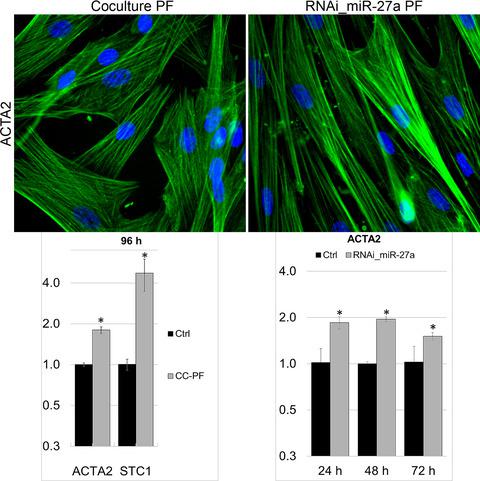当前位置:
X-MOL 学术
›
FEBS Open Bio
›
论文详情
Our official English website, www.x-mol.net, welcomes your feedback! (Note: you will need to create a separate account there.)
Deregulation of miR-27a may contribute to canine fibroblast activation after coculture with a mast cell tumour cell line.
FEBS Open Bio ( IF 2.6 ) Pub Date : 2020-04-01 , DOI: 10.1002/2211-5463.12831 Matias Aguilera-Rojas 1 , Soroush Sharbati 1 , Torsten Stein 1 , Ralf Einspanier 1
FEBS Open Bio ( IF 2.6 ) Pub Date : 2020-04-01 , DOI: 10.1002/2211-5463.12831 Matias Aguilera-Rojas 1 , Soroush Sharbati 1 , Torsten Stein 1 , Ralf Einspanier 1
Affiliation

|
The tumour microenvironment comprises a diverse range of cells, including fibroblasts, immune cells and endothelial cells, along with extracellular matrix. In particular, fibroblasts are of significant interest as these cells are reprogrammed during tumorigenesis to become cancer‐associated fibroblasts (CAFs), which in turn support cancer cell growth. MicroRNAs (miRNAs) have been shown to be involved in this intercellular crosstalk in humans. To assess whether miRNAs are also involved in the activation of fibroblasts in dogs, we cocultured primary canine skin fibroblasts with the canine mast cell tumour cell line C2 directly or with C2‐derived exosomes, and measured differential abundance of selected miRNAs. Expression of the CAF markers alpha‐smooth muscle actin (ACTA2) and stanniocalcin 1 confirmed the activation of our fibroblasts after coculture. We show that fibroblasts displayed significant downregulation of miR‐27a and let‐7 family members. These changes correlated with significant upregulation of predicted target mRNAs. Furthermore, RNA interference knockdown of miR‐27a revealed that cyclin G1 (CCNG1) exhibited negative correlation at the mRNA and protein level, suggesting that CCNG1 is a target of miR‐27a in canine fibroblasts and involved in their activation. Importantly, miR‐27a knockdown itself resulted in fibroblast activation, as demonstrated by the formation of ACTA2 filaments. In addition, interleukin‐6 (IL‐6) was strongly induced in our fibroblasts when cocultured, indicating potential reciprocal signalling. Taken together, our findings are consistent with canine fibroblasts being reprogrammed into CAFs to further support cancer development and that downregulation of miR‐27a may play an important role in the tumour–microenvironment crosstalk.
中文翻译:

与肥大细胞肿瘤细胞系共培养后,miR-27a的失调可能有助于犬成纤维细胞的活化。
肿瘤微环境包括各种各样的细胞,包括成纤维细胞,免疫细胞和内皮细胞,以及细胞外基质。特别是,成纤维细胞引起了人们的极大兴趣,因为这些细胞在肿瘤发生过程中被重新编程成为癌症相关的成纤维细胞(CAF),从而支持癌细胞的生长。微小RNA(miRNA)已显示参与人的这种细胞间串扰。为了评估miRNA是否也参与了犬成纤维细胞的活化,我们将犬原代皮肤成纤维细胞与犬肥大细胞瘤细胞C2直接或与C2衍生的外泌体共培养,并测量了选定miRNA的差异丰度。共培养后,CAF标记α-平滑肌肌动蛋白(ACTA2)和斯坦钙蛋白1的表达证实了我们的成纤维细胞被激活。我们显示成纤维细胞显示出miR-27a和let-7家族成员的显着下调。这些变化与预测的目标mRNA的显着上调相关。此外,miR-27a的RNA干扰敲低表明,cyclin G1(CCNG1)在mRNA和蛋白质水平上表现出负相关性,这表明CCNG1是犬成纤维细胞中miR-27a的靶标并参与其激活。重要的是,miR‐27a敲除本身会导致成纤维细胞活化,这可以通过ACTAA2细丝的形成来证明。此外,共培养时在我们的成纤维细胞中强烈诱导了白介素-6(IL-6),表明潜在的相互信号传递。在一起
更新日期:2020-04-01
中文翻译:

与肥大细胞肿瘤细胞系共培养后,miR-27a的失调可能有助于犬成纤维细胞的活化。
肿瘤微环境包括各种各样的细胞,包括成纤维细胞,免疫细胞和内皮细胞,以及细胞外基质。特别是,成纤维细胞引起了人们的极大兴趣,因为这些细胞在肿瘤发生过程中被重新编程成为癌症相关的成纤维细胞(CAF),从而支持癌细胞的生长。微小RNA(miRNA)已显示参与人的这种细胞间串扰。为了评估miRNA是否也参与了犬成纤维细胞的活化,我们将犬原代皮肤成纤维细胞与犬肥大细胞瘤细胞C2直接或与C2衍生的外泌体共培养,并测量了选定miRNA的差异丰度。共培养后,CAF标记α-平滑肌肌动蛋白(ACTA2)和斯坦钙蛋白1的表达证实了我们的成纤维细胞被激活。我们显示成纤维细胞显示出miR-27a和let-7家族成员的显着下调。这些变化与预测的目标mRNA的显着上调相关。此外,miR-27a的RNA干扰敲低表明,cyclin G1(CCNG1)在mRNA和蛋白质水平上表现出负相关性,这表明CCNG1是犬成纤维细胞中miR-27a的靶标并参与其激活。重要的是,miR‐27a敲除本身会导致成纤维细胞活化,这可以通过ACTAA2细丝的形成来证明。此外,共培养时在我们的成纤维细胞中强烈诱导了白介素-6(IL-6),表明潜在的相互信号传递。在一起



























 京公网安备 11010802027423号
京公网安备 11010802027423号